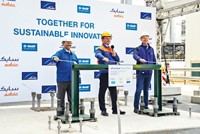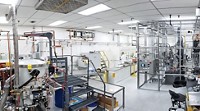Advertisement
Grab your lab coat. Let's get started
Welcome!
Welcome!
Create an account below to get 6 C&EN articles per month, receive newsletters and more - all free.
It seems this is your first time logging in online. Please enter the following information to continue.
As an ACS member you automatically get access to this site. All we need is few more details to create your reading experience.
Not you? Sign in with a different account.
Not you? Sign in with a different account.
ERROR 1
ERROR 1
ERROR 2
ERROR 2
ERROR 2
ERROR 2
ERROR 2
Password and Confirm password must match.
If you have an ACS member number, please enter it here so we can link this account to your membership. (optional)
ERROR 2
ACS values your privacy. By submitting your information, you are gaining access to C&EN and subscribing to our weekly newsletter. We use the information you provide to make your reading experience better, and we will never sell your data to third party members.
Investment
In new strategy, BASF will count the cost of CO2
German giant bets on new plan to decouple CO2 emissions from production growth
by Alex Scott
February 25, 2019
| A version of this story appeared in
Volume 97, Issue 8

Climate change is the biggest challenge of our time, according to BASF’s chairman, Martin Brudermüller. While the chemical industry by its nature cannot do without carbon, an element that it emits in the form of a number of greenhouse gases, companies can at least manage it, he says.
Now, BASF has unveiled a program to do just that. The firm, one of the world’s largest chemical companies, has pledged to stop increasing carbon dioxide emissions—even though it expects to increase chemical production by up to 50% through 2030.
Brudermüller acknowledges that the strategy could be a financial burden, at least in the short term. “There’s no such thing as a free lunch,” he told journalists at a recent briefing on the new strategy at the firm’s headquarters in Ludwigshafen, Germany. But Brudermüller, who is also the firm’s chief technology officer, said it will be good for the company, and the planet, in the long term.
BASF intends to cap its CO2 emissions through a suite of measures that include heating petrochemical reactors with electricity rather than fossil fuels, switching to renewable energy, developing catalytic processes that are lower in CO2 emissions, and, to a lesser extent, using waste CO2 as a raw material.
BASF is already the fifth-best-performing chemical company in the world when it comes to business readiness for a low-carbon transition, according to 2017 data crunched by CDP Worldwide, a nonprofit organization that analyzes greenhouse gas emissions.
Overall, though, the industry is a poor performer. “The chemicals sector remains part of the problem as it struggles to move away from highly polluting upstream processes,” CDP states in an online report.
Cutting carbon
BASF aims to cut CO2 emissions per unit of product by one-third by 2030.
| METRIC TONS OF CO2/METRIC TON OF PRODUCT | TOTAL CO2 RELEASED, MILLION METRIC TONS | |
|---|---|---|
| 1990 | 2.2 | 40 |
| 2018 | 0.6 | 22 |
| 2030 | 0.4 | 22 |
Source BASF.
Those ahead of BASF in the CDP ranking are AkzoNobel, at number 1; DSM; Johnson Matthey; and DuPont. The worst performers, CDP says, are Formosa Plastics, in last place; LyondellBasell Industries; and Dow Chemical.
BASF aims, by 2030, to reduce CO2 emissions by one-third for each metric ton of product it makes. This effort “will require entirely new technologies,” Brudermüller said. BASF currently has 3,000 projects in its research pipeline, and many of them are aimed at reducing CO2 emissions, the firm says.
One way BASF expects to have a major impact is by replacing fossil-fuel-based heating systems with those powered by renewable electricity.
BASF wants to install such technology in the naphtha crackers that produce its building-block chemicals. The switch could cut CO2 emissions per cracker by 90%—or by 750,000 metric tons (t) annually across the company. BASF is developing the technology, which it says will be a world first, in association with Linde, a builder of conventional fossil-fuel-based ovens.
A major challenge is delivering electricity to a cracker’s heating element at voltages that are safe for workers and instruments, project leader Kiara Kochendörfer said. Next steps will involve testing prototype heating elements at temperatures of about 1,000 °C.
“If it works for crackers, we can apply it to other furnaces,” Kochendörfer said. In tandem with this approach, BASF plans to markedly increase the proportion of energy it draws from renewable sources.
Advertisement
BASF is also deploying its catalysis know-how to reduce CO2 emissions in its chemical production processes. “No other company has such a wide capability in catalysts. We are not generating any quantum leaps but step-by-step improvements, and these continue to be very promising,” said Brudermüller, a PhD chemist who was a postdoc at the University of California, Berkeley.
Although BASF currently makes basic olefins in naphtha crackers, the firm says it could significantly reduce CO2 emissions by producing them via the “dry reforming” of methane. In this process, synthesis gas is transformed into olefins via the intermediate dimethyl ether. At the heart of the process is a new high-performing catalyst system featuring two spinel-type materials based on nickel and cobalt, said Nils Bottke, head of petrochemical catalyst research.
If this process were also heated with renewable electricity rather than fossil fuels, it would be a net consumer of CO2, Bottke said. BASF’s CO2 emissions from olefin production in Ludwigshafen alone are about 1 million t per year.
Some companies are pushing the use of CO2 as a chemical raw material. Notably, the German firm Covestro has started using the gas to make polyurethane. But BASF plans to only rarely consider using CO2 as a raw material because such reactions typically require large amounts of energy. Getting energy from a renewable source doesn’t add CO2 to the environment, but it’s still expensive.
“There are few things outside nature where it makes sense to use CO2 as a raw material,” Brudermüller said.
One exception could be reacting CO2 with ethylene to make sodium acrylate, the starting material for superabsorbent polymers used in products such as diapers.
In association with Heidelberg University, BASF has successfully tested the chemistry at the lab scale. “The process essentially is about switching one carbon molecule—a fossil fuel—for another in the form of waste CO2,” said Rocco Paciello, BASF executive expert for homogeneous catalysis.
About 50% of the weight of the sodium acrylate can be derived from CO2. Such a switch would represent a substantial opportunity for BASF to cut CO2 emissions, as the firm currently produces almost 600,000 t per year of the superabsorbent polymer.
“But the big challenge is the energy cost of using a very unreactive molecule like CO2,” Paciello said. Without a subsidy of some kind, the process would be too expensive, he said.
A possible savior would be a hike in the value of greenhouse gas emissions traded on the European Union’s Emissions Trading System (ETS). BASF and other European industrial firms can earn CO2 emission credits when they reduce their emissions. Currently on the ETS market, 1 t of CO2 emissions reduced is worth a little more than €20, or about $23.
“It is too early to say what it is, but I think we need a relatively high CO2 price here,” said Brudermüller, referring to making sodium acrylate from CO2. The project highlights the dilemma BASF and other chemical companies face when seeking to switch to more sustainable processes.
While Brudermüller expects his carbon-reduction strategy to cause BASF financial pain, some industry watchers think the strategy could actually boost profits, even in the near term.
In a recent report, Sebastian Bray, an analyst at the German investment bank Berenberg, says it would not be far fetched for ETS prices to rise to about €50 next year.
In this scenario, not making major cuts in CO2 emissions would be more costly than doing so, Bray suggests. “Increases in carbon prices could . . . be a significant headwind to the profitability for European chemicals companies in years to come,” he writes.
The scenario would give BASF a relative advantage over its less carbon-efficient competitors, Bray adds. Brudermüller may be in line for a free lunch after all.




Join the conversation
Contact the reporter
Submit a Letter to the Editor for publication
Engage with us on Twitter